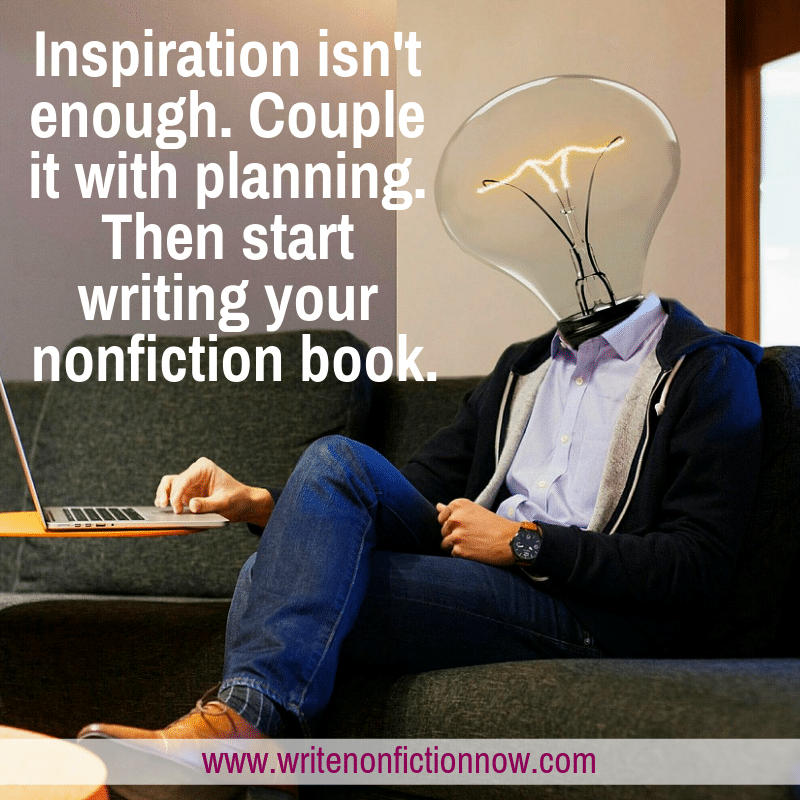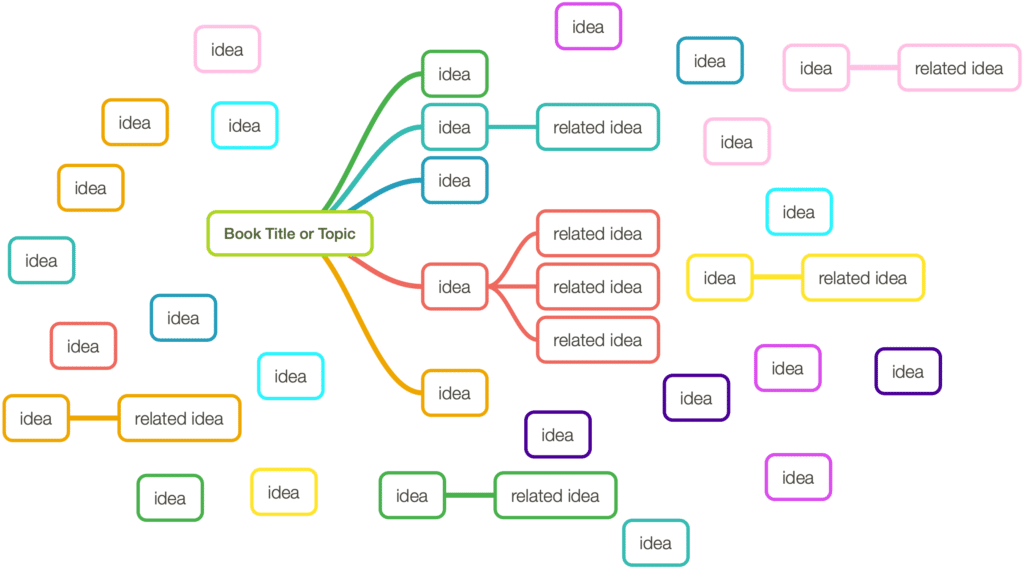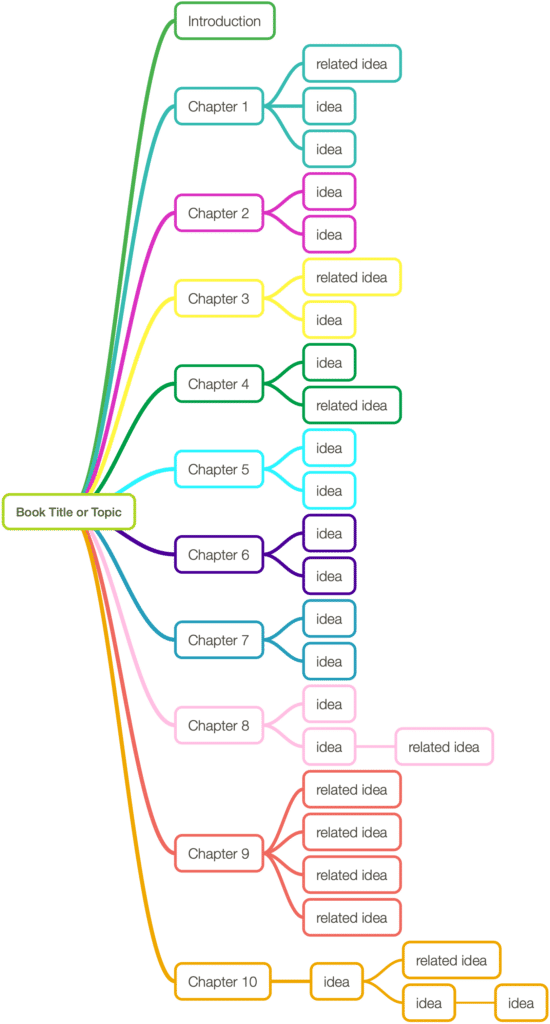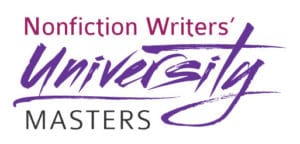 Most people who decide to start a nonfiction book project begin writing the moment the light bulb goes on. Writing when inspired can make you quite productive but also can produce a manuscript that isn’t as salable as you’d like. To avoid this problem, start your nonfiction book project by coupling inspiration with planning. This will allow you to write productively and effectively so you end up with a book that sells.
Most people who decide to start a nonfiction book project begin writing the moment the light bulb goes on. Writing when inspired can make you quite productive but also can produce a manuscript that isn’t as salable as you’d like. To avoid this problem, start your nonfiction book project by coupling inspiration with planning. This will allow you to write productively and effectively so you end up with a book that sells.
Relying on inspiration alone can cause your nonfiction book project to end up leading readers toward detours and unexpected destinations rather than on a straight path from point A to point B, which is what nonfiction readers expect. That’s why you want to use that light-bulb moment to illuminate a clear writing path for you and your book. You want to use it to create an inspired book plan. That plan ensures you produce a book that gives readers what they want and need.
Increase Your Odds of Finishing Your Nonfiction Book Project
In 2008, The New York Times reported that 81% of the U.S. population—more than 200 million people at that time—wanted to write a book. Other statistics say 97% of people who start to write a book never finish it. That doesn’t have to be you.
Knowing how to start writing a nonfiction book can increase the odds that you finish your manuscript and produce work that readers find valuable. Use a proven step-by-step process to help you begin the process of writing a book on the right foot—and become part of the 3% who do, indeed, complete the manuscript.
February Nonfiction Writer’s Challenge
To complete this month’s challenge, use the following five steps to start your nonfiction book project. (For more information, watch the replay of “How to Start a Nonfiction Book Project,” the February 2019 Nonfiction Writers’ University educational event.)
1. Brainstorm your content.
Many writers have no idea how to determine what content to include in their nonfiction book project. Like them, you may have an idea, but that’s it. So, it’s time to uncover more ideas—enough to fill a book. Get out a large sheet of poster board, pin up a long section of a paper roll, or load up your favorite mind-mapping tool. Then let your mind go wild! Brainstorm all the ideas you can think of that relate to your book subject. An initial mind map of your book content could look like this:

2. Organize your content into chapters.
Once you’ve completed your brainstorming exercise, organize all the ideas and subjects into related groupings. These will become your chapters. You may need to brainstorm more ideas so each chapter has enough content. Also, you will need to organize the chapters into a logical sequence, which will become the table of contents for your nonfiction book project. If you use a mind map, the exercise initially will end up looking like this:

As you brainstorm content ideas for each chapter, your mind map will get fuller and more complete. When each topic area has enough information for a full chapter, you are ready to move on to the next step.
3. Write chapter summaries or create detailed chapter outlines.
Chapter summaries consist of one to five paragraphs that offer a brief description of the content in each chapter. You can create your summaries with bullets, outlines or a combination of paragraphs and bullets. The summaries give you clarity about what to write by forcing you to determine the content of your entire book before you write a word.
4. Craft a book pitch.
Your book pitch is a quick way to tell others about your nonfiction book and to remind yourself what your book is about. This 50 to 100 word “elevator speech” helps you get clear and remain focused on the topic and goal of your book. Here’s an easy formula for writing a pitch: [Title of book] is a [type of book (ex. prescriptive, memoir, tip, narrative nonfiction] that [verb] [audience] [benefit] [strategy]. For example, “The Author Training Manual is a nonfiction how-to book that trains writers to craft books that sell by detailing nine steps they must take (the manual) and providing numerous exercises (the training) they can complete to achieve that goal.” Or read this post to discover more ways to write a pitch.
5. Hone your content and perfect your idea.
To ensure your nonfiction book project is marketable, you must know what your audience needs and wants and how to make your book stand out from the competition. That’s why you must identify your market(s) and evaluate other books written on the topic. Your market and competitive analyses help you improve your idea and ensure the content in your book is unique and necessary both for readers and in the category where it will be placed in a bookstore. Once you have completed these two analyses, review your pitch, table of contents, and chapter summaries to determine if you can do a better job of targeting your audience or improving on competing books. Retool your idea as necessary. (If you need more help on this step—or any of the steps mentioned in this challenge, read The Author Training Manual.
When and How to Begin Writing
You could work on the five steps outlined above for a long, long time and never get started writing your book. Don’t fall into that trap, which also can place you firmly in the 97% of writers who never complete their book projects.
Instead, give yourself a deadline for completing these steps. Then move on to writing!
Your table of content and chapter summaries provide a perfect and easy-to-use writing guide. Each sentence, online item, or bullet gives you clear direction about what to write first, second, third, and so on until the end of the chapter (and the end of the book).
Use your pitch as a constant reminder of what your book aims to accomplish. Read it often. Ask yourself if each section or chapter you complete aligns with your pitch and fulfills its promise.
Set Deadlines and Meet Quotas
Finally, set a reasonable deadline for completion of the first draft of your nonfiction book project. Determine how many words you can write per day or week. Approximate how many words the book will have or determine how long it will take to write a chapter.
Then work backward from the deadline you set to finish your first draft. If you want to finish in six months and you think the book will be 60,000 words long, you need to complete 10,000 words per month. Determine how many words you can write each day or week. Then meet those word-count quotas.
With this step-by-step guide, you are sure to be ready to start your nonfiction book project—and finish it. Not only that, by completing this challenge, you’ll stand a higher chance of producing a manuscript that can be turned into a book that sells, gets read and makes a positive and meaningful difference in readers’ lives.
And you’ll be inaugurated into the 3% club.
Take this challenge! Then, in a comment below, tell me know how this book-planning process worked for you. Or tell me about the strategy you used to begin writing your nonfiction book.
For more information related to this challenge, watch the replay of “How to Start a Nonfiction Book Project,” the February 2019 Nonfiction Writers’ University educational event.
 Would you like to learn more about becoming a nonfiction author? If you aren’t sure how to get started or to move forward on your nonfiction writing journey, check out the Nonfiction Writers’ University MASTERS program. Learn all the steps to becoming a successful—and profitable—author. Discover how (finally) to write consistently, boldly, enthusiastically, and productively. Develop the mindsets, strategies, habits of the world’s most successful writers. Make your difference today. Click here to learn more. (And if you aren’t ready for the Nonfiction Writers’ University Masters program, explore the Nonfiction Writers’ University. You can enjoy a 30-day trial membership for only $1.)
Would you like to learn more about becoming a nonfiction author? If you aren’t sure how to get started or to move forward on your nonfiction writing journey, check out the Nonfiction Writers’ University MASTERS program. Learn all the steps to becoming a successful—and profitable—author. Discover how (finally) to write consistently, boldly, enthusiastically, and productively. Develop the mindsets, strategies, habits of the world’s most successful writers. Make your difference today. Click here to learn more. (And if you aren’t ready for the Nonfiction Writers’ University Masters program, explore the Nonfiction Writers’ University. You can enjoy a 30-day trial membership for only $1.)Photo courtesy of Balintmohamed_hassan / Pixabay.com
DARLA DEMORROW says
I like the idea of crafting a book elevator pitch early in the process. It’s very hard to do, but focuses your energy!